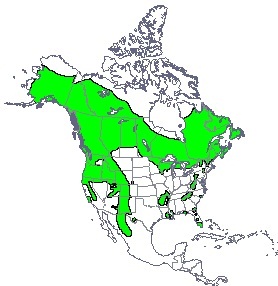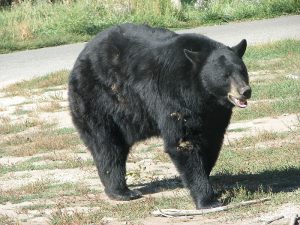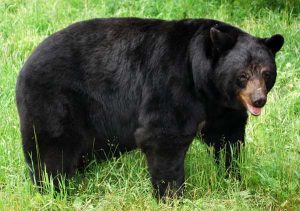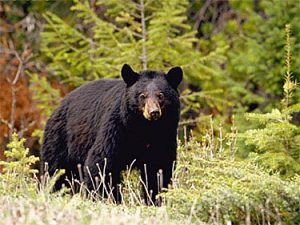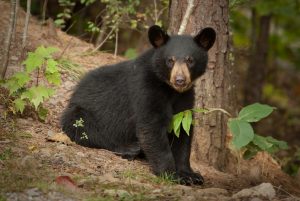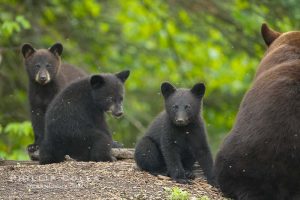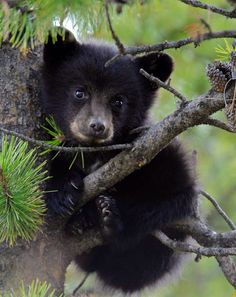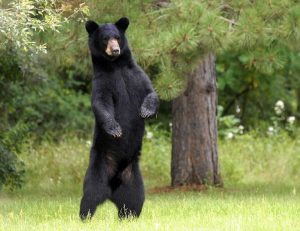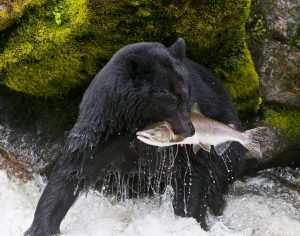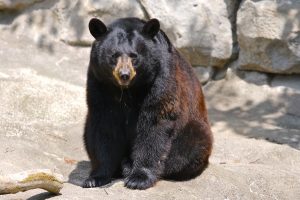American Black Bear
The American black bear is a species of medium-sized bears found in North America. Since its population has grown over the last two decades, it has become the most familiar and widely distributed of all the bear species in America. Despite their name, black bears exhibit variation in coloration. It is believed that this variability is related to the diversity of their habitat, as bears with lighter colors are found in open habitats.
Scientific Classification
| Kingdom | Animalia |
| Phylum | Chordata |
| Class | Mammalia |
| Order | Carnivora |
| Family | Ursidae |
| Genus | Ursus |
| Scientific Name | Ursus americanas |
Quick Information
| Similar Species | Asian black bear |
| Description | Broad skull, narrow muzzle, large jaw hinge; small rounded ears set back on its head; soft fur, dense undercoat, long, thick, coarse guard hairs; shoulder hump is absent, and its profile is less concave than the brown bears |
| Size | Head-body length: 47.2-74.8 in (1.2-1.9 m) Height at the shoulder: 27.6-39.4 in (0.7-1 m) |
| Weight | 200-600 lb (90-270 kg) |
| Color | Black, blue-black, blue-gray, cinnamon, brown, white (very rare) |
| Distribution | Northern parts of Mexico; much of Canada and the US |
| Habitat | Primarily boreal and temperate forests; also lives in rainforests, coniferous and deciduous forests, tundra, scrub forests, swamps, and mountainous regions |
| Lifespan/Life Expectancy | Average of 18 years in the wild; can live for over 23 years |
| Diet | Omnivore; feeds on herbaceous vegetation, plants, buds, roots, fleshy fruits, nuts; insects such as ants, yellow jackets, bees and their larvae; fishes including trout, salmon, catfish, and suckers; preys on moose and elk calves, young white-tailed deer, and mules; also consumes carrion |
| Sounds | Tongue-clicks and grunts used by mother bears; other bears also make such calls before playing or mating; the cubs make a pulsing hum when nursed; an intense, pulsing sound is used as a threatening call |
| Adaptations | Strong curved claws help in ripping logs and climbing trees; a vomeronasal organ improves its sense of smell and taste; a long, sticky tongue for fetching ants from their colonies; a reflective layer of tissues tapetum lucidum aids night vision |
| Diseases | Canine hepatitis virus, tick/mosquito-borne diseases, rabies, pseudorabies, Q-fever, brucellosis, plague, tularemia |
| Size of litter | 1-6 cubs; 2 cubs (average) |
| Weight at birth | 280-450 g |
| Gestation Period | 220-235 days |
| Predators/Competition | Gray wolves, adult brown bears; bobcats, cougars, and coyotes may kill bear cubs |
| IUCN Conservation Status | Least Concern |
| Why is it endangered | Illegal poaching or trapping, auto-collisions |
Behavior
The black bears, being solitary animals with opportunistic feeding behaviors, typically forage alone during twilight. However, they will tolerate other bears and feed in groups if sufficient amount of food is available in an area.
Depending on regional weather conditions, black bears usually hibernate for 3-8 months. They may hibernate for a brief period, and may wake up to forage for food in regions where the winter is comparatively warm throughout the winter.
Mating and Reproduction
American black bears mate during June-August, during which the female bears remain in estrus. A male may have several mating partners, but in order to claim a female, large, dominant males do not hesitate to fight fierce battles with other mature males. After copulation, the fertilized eggs do not attach and become embedded in the womb until November.
A delayed embryonic development takes place when the female bear is in its last few weeks of pregnancy. Litters are produced during late January-early February while the mother is hibernating in its den. Females typically construct dens in trees, caves, or by digging out large cavities in snow.
Life Cycle
The black bear cubs are born blind, and they have an underdeveloped hind quarter. They can open their eyes at 28-40 days, while they start walking 5 weeks after birth. The young bears, weaned at 6-8 months of age, remain with their mother until reaching independence at 17 months. At that point of time, the mother bear again enters its estrus and thus, separates from its cubs to avoid the aggression of adult males during the mating season. Young bears attain sexual maturity at 3-5 years but become full grown at 10-12 years.
Interesting Facts
- In Canada’s Labrador tundra, the American black bears occupy the niche of the grizzly/brown bears.
- Known for their great strength, black bears can easily topple over large rocks weighing well over 300 pounds.
- They have a sure-footed, rhythmic movement with a running speed of 25-30 mph.
- Some of the world’s biggest captive black bears are found in the North American Bear Center in Minnesota, where Ted, a male bear weighed 950-1,000 lb (431-453 kg) in 2006.
References:
- https://en.wikipedia.org/wiki/American_black_bear
- https://www.nationalgeographic.com/animals/mammals/facts/american-black-bear
- http://animaldiversity.org/accounts/Ursus_americanus/
- https://defenders.org/wildlife/black-bear
- https://www.iucnredlist.org/species/41687/114251609
Published on August 6th 2016 by admin under Coniferous Forest Animals.
Article was last reviewed on 5th December 2024.


